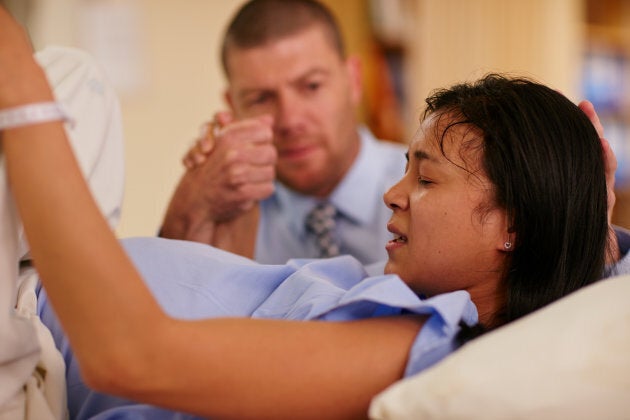
We've said it before and we'll say it again: there really is no good way for a baby to get from the inside to the outside of your body.
But if that route is through your vagina, chances are you might experience some tearing. No, we don't mean tearing up, although you might cry a little when your doctor or midwife tells you how many stitches they just sewed into your crotch. We mean vaginal tearing — a spontaneous laceration in the perineum as a result of pushing your baby out.
The American College of Obstetricians and Gynecologists estimates that between 53 and 79 per cent of vaginal deliveries will result in a laceration.
Vaginal tearing is common
"The majority of women experience some kind of tearing," Dr. Natalie Rosen, a clinical psychologist and associate professor of psychology at Dalhousie University in Halifax, told HuffPost Canada in a phone interview.
The good news is that, in most incidents, tears are mild. A highly-cited study found that 34 per cent of women experience either no tearing, or just a first-degree tear, which is superficial vagina and perineal tearing, said Rosen, who also leads Dalhousie's Couples and Sexual Health Laboratory and is a member of the Canadian Sex Research Forum.
More than half of the women in the study had second-degree tears, which are deeper and usually involve the muscle, and only about 10 per cent had third- or fourth-degree tears, which are the most severe and can extend all the way to the anus and anal sphincter, Rosen said.
Risk factors for tears include a larger baby, prolonged pushing, if it's a woman's first delivery, episiotomy, and use of forceps, Rosen said.
There will be pain

"Certainly, it's very painful," Rosen said.
But that depends on the healing, and recovery is variable, she added.
Those who experience first- or second-degree tears will likely experience discomfort for at least a week, according to Parents magazine. The nerves and full strength of the muscles will take a few more weeks of healing, the magazine noted.
Healing for third- and fourth-degree tears takes longer, plus two to three weeks of initial pain, Parents reported.
"Since severe tears into the vagina or rectum can cause pelvic floor dysfunction and prolapse, urinary problems, bowel movement difficulties, and discomfort during intercourse, it's important to share all of your symptoms with your doctor, no matter how embarrassing they may seem," Parents said.
In general, stitches take seven to 10 days to dissolve, but the perineum might need six to eight weeks to heal completely, Today's Parent reported.
There can be long-term consequences

For most moms, healing does progress and they find themselves feeling better after a month or so, Rosen said. But one of the longer-term consequences is painful sex, Rosen said. More significant tears or difficulty with healing after a tear is a predictor of more persistent pain problems provoked through intercourse, Rosen said.
And some women have scar tissue, which adds to pain during sex, she said. Moreover, some women will need additional repairs, which prolongs healing.
Women who experience painful postpartum sex also report more depressive symptoms, Rosen said.
"Even outside of the postpartum world, we know that pain during sex is linked to more depression and more anxiety."
A lot of women aren't aware or keep silent afterward

A lot of first-time moms aren't aware of the potential to injure themselves going into childbirth, and a lot of them don't receive adequate postpartum care to help them cope with the pain and other side effects afterward, according to a 2016 investigation by Cosmopolitan.
"Obstetric training is understandably focused on life-threatening childbirth complications, like hemorrhage or infection. Non-life-threatening (but still painful and incapacitating) problems get less attention," Cosmopolitan wrote, paraphrasing Dr. Sarah Fox, a professor and researcher at Brown University and former president of the International Pelvic Pain Society.
After giving birth, a lot of women suffer in silence, BBC reported in their own investigation.
"(They're) embarrassed to seek help, or unsure whether their symptoms are normal after giving birth. And often when they do seek help, they are ignored or told by their doctors that their symptoms are to be expected and will improve," BBC said.
There are ways to cope

If you're experiencing pain or other symptoms after a tear, be sure to consult with your healthcare provider, Rosen said.
"Don't suffer in silence. There's a real focus on the baby and making sure that they're OK, and moms tend to ignore their own symptoms," Rosen said.
In the short-term, Today's Parent recommends keeping the perineum clean using a squirt bottle of warm water after peeing. Sitz baths can also be soothing, the magazine noted. Those with more serious tears shouldn't avoid all activity, but should try not to stand or walk too much during the healing period, they added.
A pelvic floor physiotherapist can also provide some relief, Rosen said.
When you're far enough down the road to think about sex, use a water-based lubricant, Rosen said. And if intercourse is still painful during that first year, engage in other sexual activities.
"Find ways to connect that aren't linked to pain," she said.
There have been some advances

In 2016, the American College of Obstetricians and Gynecologists (ACOG) issued a new practice bulletin to help OB-GYNs prevent and manage tears during a vaginal delivery.
"Perineal massage, either antepartum or during the second stage of labour, can decrease muscular resistance and reduce the likelihood of laceration. Moreover, use of warm compresses on the perineum during pushing can reduce third-degree and fourth-degree lacerations," noted a press release about the bulletin.
In the U.K., a joint project between the Royal College of Obstetricians and Gynaecologists and the Royal College of Midwives developed some new techniques to help reduce the incident of vaginal tears, and those are being rolled out across a dozen hospital, BBC reported.
And a 2015 clinical practice guideline from the Society of Obstetricians and Gynaecologists of Canada said that "slowing down the delivery of the head and instructing women to not push at the delivery of the head, using thus only the uterine expulsive efforts, decreases the incidence of (obstetrical anal sphincter injuries) by 50 per cent to 70 per cent."
Also on HuffPost: